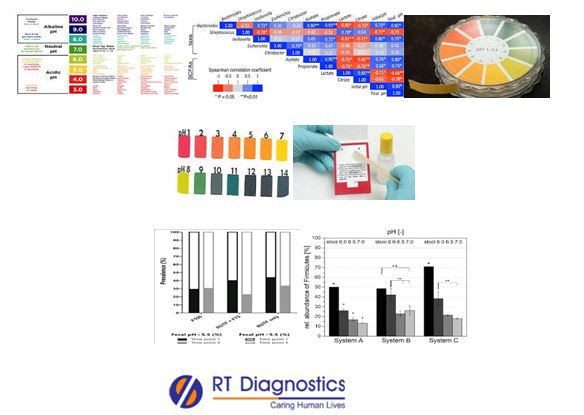Motion - pH:
Why Motion pH Test ?
CLINICAL INFORMATION
A stool or feces examination is also known as an enteric sample specimen analysis. It comprises of a series of tests. Routine stool test is performed to examine for hidden occult blood, fat meat fibers, bile, WBCs, sugars (fecal sample as a tool of evidence of a medical condition) etc. This test result helps in diagnosing medical conditions including inflammatory bowel disease, gastric or colon cancer etc. This test may be ordered over a period of time if infection gets worse. Complications due to untreated chronic enteric pathologies can lead to severe symptom of dehydration, electrolyte imbalance etc.
These tests when performed, helps to diagnose certain conditions affecting the GIT (mainly the lower GI abnormalities) – such as Infection and/or parasitic infestations (parasites like protozoan – trophozoites and cysts, viruses, bacteria like C. difficile, Campylobacter, E.coli, Salmonella, Shigella, Plesiomonas, vibrio etc), Mal-absorption eg Celiac disease, IBD like Ulcerative colitis, Hemorrhoids, Polyps, Cancer, Pancreatitis (fatty stools - Steatorrhea) etc. A feces or a stool test is ordered by a physician in case of certain indications with signs and symptoms (clinical manifestations) including diarrhea, stool with mucus or blood, stomach cramping, nausea, vomiting fever etc. Stool culture and sensitivity test is also performed to detect the presence of disease causing harmful microbes in sample specimen of suspected patients. Moreover stool may be tested for the presence of parasites, spores, ova (egg of the parasite) and also round worm, flat worm, hook worm, tape worm etc, under the microscope – by a routine microscopic study. A normal routine stool test is also performed to examine for occult blood loss in feces, bile water stools, WBCs in infections (in colon or rectum), sugars etc (these fecal sample specimen are used as a tool of evidence for certain abnormal (medical) conditions, for example - in systemic manifestations like sepsis; but particularly when it is mediated with the GIT diseases/disorders etc). Additional tests include isolation in cell culture, WBCs – Differential count, Calprotectin test, fecal immunochemical tests / Antigen tests eg. Yersinia test, Giardia test, Salmonella culture test, Cryptosporidium test, Test for Entamoeba hystolytica, Test for the presence of taeniasis etc. Other tests include CBC, CRP and ESR (inflammation), widal test, microscopic examination for gram stain, other stool tests to examine egg, cyst, ova, spores, parasites test for bacterial toxins, viral antigen stool test, Clostridium difficile test – toxin, shiga like toxin test by enzyme immunoassay, trypsin/chymotrypsin test, Campylobacter culture test, H.pylori antigen test, urine culture, abdominal ultra sound, abdominal CT Scan, contrast enema X-ray, PCR etc. Hence from all possible differential diagnosis, these tests help physician to establish a confirmative definitive diagnosis. pH is defined as the negative logarithm of hydrogen ion concentration. pH indicates the concentration of hydrogen ions in a solution. Hence pH is a figure expressing the acidity or alkalinity of a solution on a logarithmic scale on which 7 is neutral. Values lower than 7 are acidic and the values higher than 7 are basic or alkaline in nature. The significance of body fluid pH is intended to assess the pH in the body fluids. Since pH indicates if the body/Bio- fluid is acidic, alkaline or neutral, it helps to distinguish between an infection and inflammation. The sample specimen is usually Intra-Vascular Fluid i.e Blood (serum/plasma) and/or body fluids. Body/Bio-Fluid Tests: Body Fluids include Peritoneal/Ascitic fluid (Ascites) – in peritonitis (inflammation of the lining of the inner abdominal wall etc), Pericardial fluid, infected pleural fluid causing pleural effusion, Bronchial Wash, Drain or aspiration Fluids - Paracentesis, Thoracocentesis, aspiration of bone marrow, aspiration of amniotic fluid, JP Drain and /or blood, urine, saliva, sweat, bile fluid, seminal fluid, vaginal fluid, synovial fluid, nasal fluid, CSF, lymph, endolymph etc can provide a vital clue in the biochemical investigation of pathologies in certain disorders or disease conditions in certain differential diagnosis to arrive in a conclusive definitive diagnosis and also for prognosis. Significance of pH test on body fluids Test: The clinical importance of pH of pleural, pericardial, gastric and ocular fluids is seen in certain pathological conditions. The normal pH of gastric content is less than 3.5 and any value above pH of 3.5 is considered abnormal. PH of pericardial fluid has been used to differentiate between inflammatory (pH 7.06 +/- 0.07) and non-inflammatory (pH 7.42 +/- 0.006) cause of pericardial effusion. the pH of pleural fluid may also be ordered when evaluating the nature of pleural effusion. Transudative pleural effusion is due to pressure-induced fluid leakage and has a distinctive pH of range of 4.5 to 5.5, while an exudative pleural effusion due to inflammation-mediated fluid leakage is a pH of a distinguished range of 7.30 to 7.45. Hence these altered pH in body fluids certainly helps in screening for the diagnosis of certain pathological states of the body.

General Instructions:
Sample Requirement: Specimen –Fecal or Stool Sample.Test Preparation: None.
NOTE - Sample for specimen collections may vary based on the patient’s condition/cases according to the patient’s presenting complaints/signs or symptoms:
SPECIMEN REQUIREMENT (Special or Rare Cases) - As instructed and guided by Physician / Clinician / Pathologist / as per Laboratory’s requirements, according to procedures and protocols.
This Multi-Specialty Clinical Referral Laboratory RT DIAGNOSTICS provides precise and accurate tests with an extensive range of testing services to the medical centres to help in the diagnosis and identification of pathology in the test specimens for infectious diseases and also to evaluate the function of organ systems of the patient. It prevents further complications and helps to stabilize and restore health to near normalcy at the earliest without delay.



